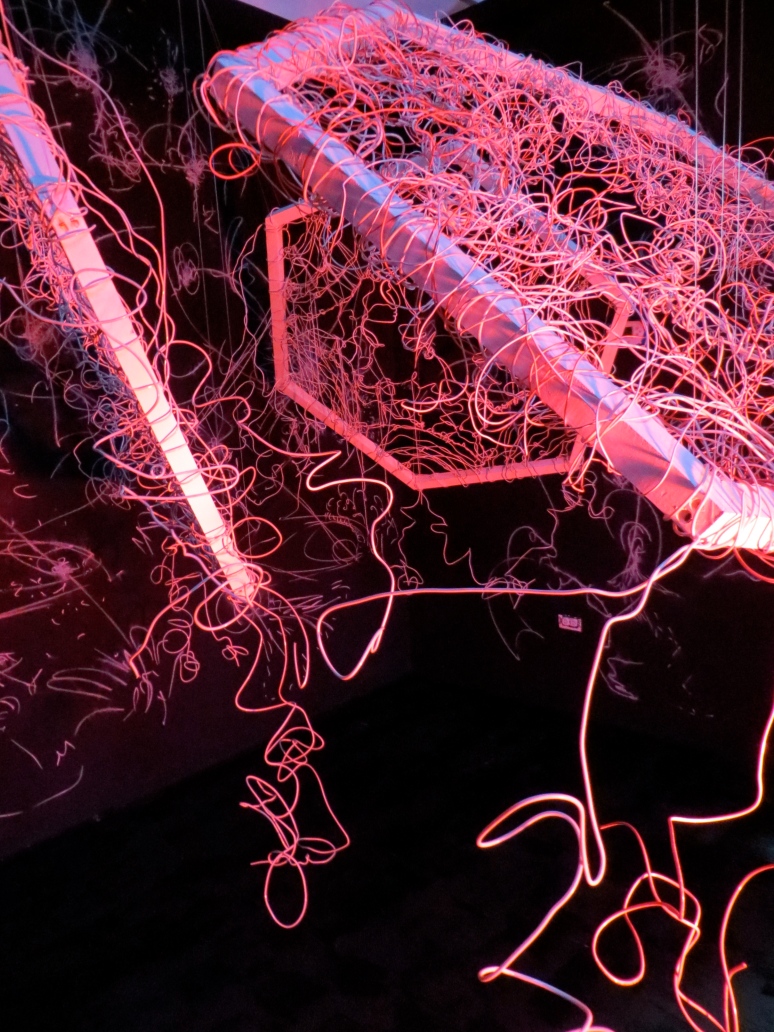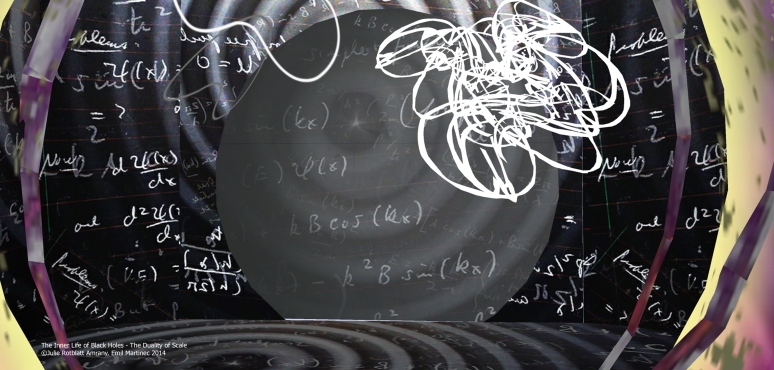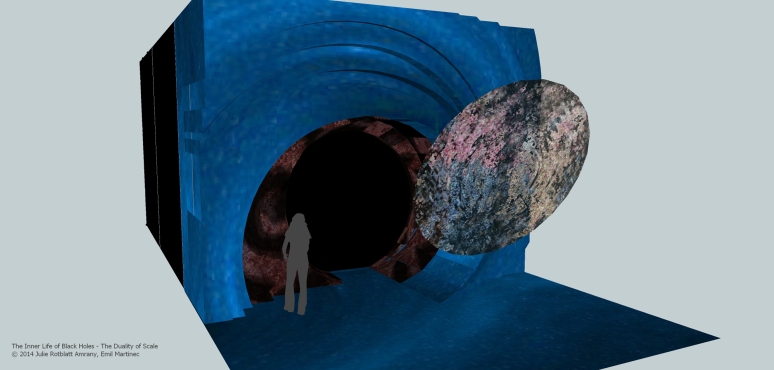Art & Science Installations
Interstitial Space

Wood, wire black paint and chalk.
10 feet high x 8 feet depth x 9 feet wide

Wood, wire black paint and chalk.
10 feet high x 8 feet depth x 9 feet wide

Wood, wire black paint and chalk.
10 feet high x 8 feet depth x 9 feet wide

Wood, wire black paint and chalk.
10 feet high x 8 feet depth x 9 feet wide

Wood, wire black paint and chalk.
10 feet high x 8 feet depth x 9 feet wide

Wood, wire black paint and chalk.
10 feet high x 8 feet depth x 9 feet wide

Wood, wire black paint and chalk.
10 feet high x 8 feet depth x 9 feet wide
I continued to create in a process-driven manner. I wanted to be surrounded on four-sides, with three-dimensional pieces hanging from above. As I worked, I documented my process through video. I had a wall built in a corner of my studio with two-by-fours spanning the top, creating a space that measured ten feet high by eight feet deep by nine feet wide. I painted three walls and the floor black so I could draw on the surfaces with white chalk. I was thinking about the invisible subatomic world, how particles and waves dance around in space and also how the macrocosmic universe is expanding outward. As I began to draw, my gestures poured forth like an improvisational dance. Knots and orbits emerged, while concentric lines, staccato marks, and angular tangential lines directed these nonsensical mathematically inspired symbols.
The process took a couple of hours and I only went back over the drawing later to smudge and soften some of the marks. At that juncture I wanted to bring white wire into the three dimensional space to mimic the white lines in two-dimensional space. Simultaneously I hung three hexagonal shapes of varying sizes that suggested the geometrical patterns found in nature. I wove white electrical wire throughout the shapes. They resembled neurons, which expanded the idea of interconnectedness. I wanted to create a feeling of some kind of charge in the room. Toward its completion I integrated red light and red wire for contrast, which suggested the idea of life. I also installed fiber optic neon light into the center of one of these neurons. When I shook the form it appeared to pulsate and take on its own breath.
Upon finishing the installation, I sat down and took in a deep breath of my own. Whether there was a distinction between the two breaths I am not sure. Piecing together the video was the next logical step. Each stage dictated the next sequential step to take, from drawing to installation, installation to video. I processed the video footage with effects so that it became an artwork in its own right as opposed to pure documentation. With these effects, my body in the video multiplied, disappeared and reappeared into space before my own eyes.
The invisible space I sought in making my small boxes and montages in reference to invisible space revealed itself so naturally in video. This movie blanketed the concept of other dimensions rapidly and effectively. The video aspect of my work is a good addition to the installation because it literally adds a new dimension to the space I have created. A natural flow of investigation ensues from one medium to the next.
The Inner Life of Black Holes: The Duality of Scale




The macrocosmic universe and the quantum subatomic world mirror one another in unexpected ways, and we humans inhabit the nexus between the cosmic and the subatomic scale. Both worlds are invisible to our naked eye. Gargantuan black holes inhabit the center of every galaxy, including our Milky Way, swallowing everything in their path. Black holes might also exist at quantum, subatomic scales as well; experimental physicists at CERN are currently searching for their existence.
Gravity so strong that not even a beam of light can escape – we are mesmerized by the mysteries of the immense objects known as black holes. While we cannot observe them directly, we infer their existence through the gravitational pull they exert on nearby objects. Their formation from dying stars more massive than our Sun is an inescapable conclusion of Einstein’s theory of gravity.
Absent direct experience of black holes, we can nevertheless rely on well-tested scientific ideas such as Einstein’s relativity and Schrodinger’s quantum physics to predict many of their properties. The marriage of these two circles of ideas led Stephen Hawking to conclude that a black hole’s event horizon – the point of no return – emits a subtle quantum glow. Black holes are not completely black after all, but slowly evaporate through the emission of this `Hawking radiation’.
More speculative ideas such as string theory are beginning to provide a conceptual window into the inner life of a black hole. The violent events spawned by the crushing force of gravity at the black hole’s core may access new dimensions of space and exotic objects inhabiting them, which are otherwise hidden from experience. These objects in our cosmos provide fertile ground for generating new concepts of space, time and matter. But how can we visualize this exotic realm? This question provides an impetus for artists and scientists to collaborate.
Throughout history, artists have both influenced and been inspired by science — whether it was Leonardo Da Vinci or Albrecht Durer in centuries past, drawing their way into the discovery of human anatomy, the heavens, and new technology; or Joseph Cornell in modern times deriving inspiration from astronomy. Boundaries between disciplines migrate over time, and in the overlaps lay new perspectives on the world we inhabit.
Contemporary artists such as Yoyoi Kusama and Chiharu Shiota experiment with environmental installations that explore the idea of infinite space. Other artists such as Richard Serra and Eva Hesse were influenced by “Minimalism”, exploring ideas of Phenomenology (the structure of experience and consciousness). Tony Smith’s quote: “There is no way you can frame it, you just have to experience it” sums up the subjective experience of art rooted in time unfolding and the crucial element of a viewer being engulfed in the environment. The key was to experience first hand the phenomena around you.
Physicist Emil Martinec and Artist Julie Rotblatt Amrany have collaborated on creating an art installation that will transport the viewer into the realm of the black hole, engaging all of his/her senses by losing a sense of self. It is a conceptual experience, which integrates architectural fabric, light, video, projection, sensory motion and sound devices as the viewer walks through the installation.
The viewer’s motion in front of the black hole installation causes the projection of light and images to undulate with their movements. A vortex depicts the swirl of matter being drawn into the black hole. A key property of the quantum theory of black holes posits that the information about a black hole’s internal state is coded in a subtle way on its event horizon. Thus, as the viewer walks through a portal into the next portion of the exhibit depicting the black hole interior, their image is recorded and projected back out onto a floating disk just outside the opening. This image is distorted and pixelated, representing the scrambling of information by the black hole.
The structure of the space representing the black hole interior becomes fragmented and swirls around the viewer. The structure draws you in, evoking the inability of light to escape. Fiber optics hang from above forming a vibrating network of strings. This network of membranes and strings represent the exotic multidimensional objects that string theory predicts are created by the violent collisions that occur in the core of the black hole. Leaving the singularity behind, one is led to the final space of the installation, revealing projections of outgoing ripples and mathematical calculations denoting the evaporation of the black hole through quantum processes. Sound is also integrated into the enclosure as a low rumble from the aboriginal didgeridoo reminds us of our primordial beginning.
Ideas about black holes, gravity, quanta and string theory are presented, though there is ample room for the participant to interpret, wonder and ponder the mysteries of our universe.
J.R. Amrany E. Martinec
Accelerated Dimensions



The proposed Cyclical Beginning art installation will shift from one artistic medium to another describing a path through dimensions of space, time and expression. As a viewer enters a darkened room filled with curvilinear organic shaped screens and instrumental music, they become engulfed by a multimedia experience. They will discover sculptural shapes from above and touch activated projections onto screens. Images of subatomic particles such as proton collisions and explosions will dance about the participant enabling their imagination of what it would be like to stand within a large hadron collider. Mathematical computations used in the development of particle acceleration will appear onto the participants themselves, as well as onto the floor, providing opportunity to view and reflect upon an invisible quantum world not typically observed on a daily basis.
Additional kinetic sculptural pieces will float from above, the macro cosmic universe will appear as a polarity to the microscopic world. These semi- abstract forms are significant to the idea of the formation of life itself.
In addition to the visual effects, there will be an element of sound. Critical to the exhibit, live instrumental music will be played, a digeradoo, igniting feelings of a primordial time.
The visitor will walk out of the art/science exhibit with a myriad of questions, an experience that will spark inspiration, and a new understanding of the current scientific world, they also will be left with a feeling of uncertainty.
Neuron Interface

Neuron Interface, mixed media, 2014
Imagine that all of humanity understood that life and inorganic matter in this universe or ‘Multiverse’ is all part of the same organism/mind. There would be a true synergy of nature and human.
Many forms in nature repeat themselves, take the structure of the neuron; its arms mimic branches on a tree. Trees are the largest living organisms on this planet. This interconnectedness metaphorically creates a web of understanding that nothing is separate. Even cosmic plasma has a web-like form within which stars are born; we also use silicon from asteroids to create computer chips.
As neurons within our brains continually fire electrical impulses, the potential of computer/neuron interface is unlimited. Scientists realize that this technology is already helping patients with differing disabilities, whether it is Parkinson’s or Alzheimer’s, etc. The ability for human thoughts to interface with computer chips via neurons in the brain has enormous potential.